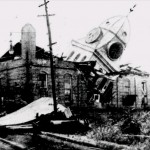
Savannah, Georgia, in the wake of the hurricane. AP photo, Milwaukee Journal, August 12, 1940.
Seventy-five years ago today, the South Atlantic coast of the U.S. was struck by what was described as the worst hurricane in several years. The storm probably formed in Cape Verde, and was first witnessed on August 5 between St. Martin and St. Thomas. It brought squalls of wind and rain to San Juan, Puerto Rico, before strengthening and turning northward. It then began moving westward toward the mouth of the Savannah River near Beaufort, South Carolina, which experienced hurricane-force winds on the 11th.
The hurricane warnings first went up in Charleston on early Sunday morning, August 11. The Charleston Amateur Radio Club was mobilized under the leadership of its president E. Linwood Sykes, W4AFQ. Critically, the group was lacking any emergency powered equipment, and a decision was made to move to a location where power was available. Member James Gantt, W4DFC, was an employee of South Georgia Power Company, and he secured a location adjoining a steam plant and made arrangements to run a temporary power line.
The hams carried equipment through two blocks of waist-deep water to the location and set up the equipment and antennas. Unfortunately, because of 75 MPH winds, the utility was unable to run the temporary power line. Fortunately, a nearby building with a substation had power available, and the equipment was moved again through water being blown from the river in sheets.
By 4:20 PM, the 40-meter station was on the air, and the operators attempted to make a scheduled contact with Savannah. However, power was already out in Savannah. Contact was made with U.S. Navy station NAO, and after shifting to 80 meters, traffic was flowing by Sunday afternoon.
A 160 meter ‘phone station owned by Dr. T.W. Zeigler, W4PG/W4CUS was also put into service. The first messages transmitted on 160 meters requested three line crews for the power company.
Since local telephone service was out of order, messages were initially relayed by wading through the tidewater to cars parked two blocks away. Messages were then taken to their destination. Later, Alexander McGaillard, W4GOQ and W4PG/W4CUS rigged up a low-power battery transmitter for the police department’s 1.7 MHz station, WCPD, and the police station was used to relay traffic between the city and the hams back at the power plant. Over 500 messages were handled, including Red Cross, press, power and telephone company, and personal messages.
Unfortunately, the South Carolina Governor Burnet R. Maybank erroneously stated in a radio broadcast that “unfounded lies” were being transmitted by amateur radio. However, the report in question had not been transmitted by amateur radio. Instead, it had been transmitted by a local broadcast station from its mobile unit on a frequency of 1670 kHz.
References
- 1940 South Carolina Hurricane at Wikipedia.
- Southeast Hurricane – August 10-18 1940 at NOAA.gov
- Atlantic Coast Amateurs Render Emergency Service, QST, Oct. 1940.
Click Here For Today’s Ripley’s Believe It Or Not Cartoon ![]()

Pingback: The Great Southeast Hurricane Of August 1940 | Weather Concierge